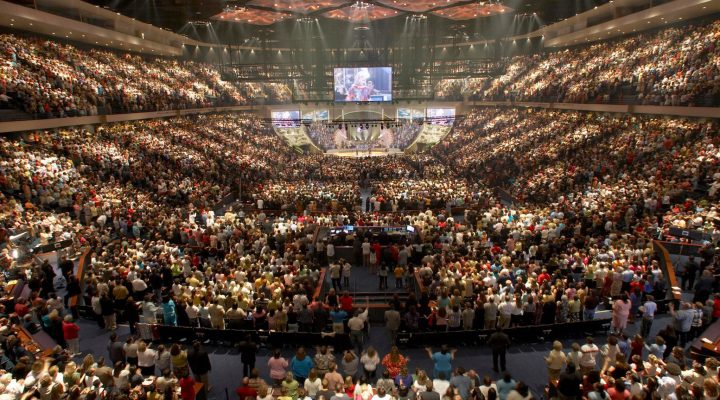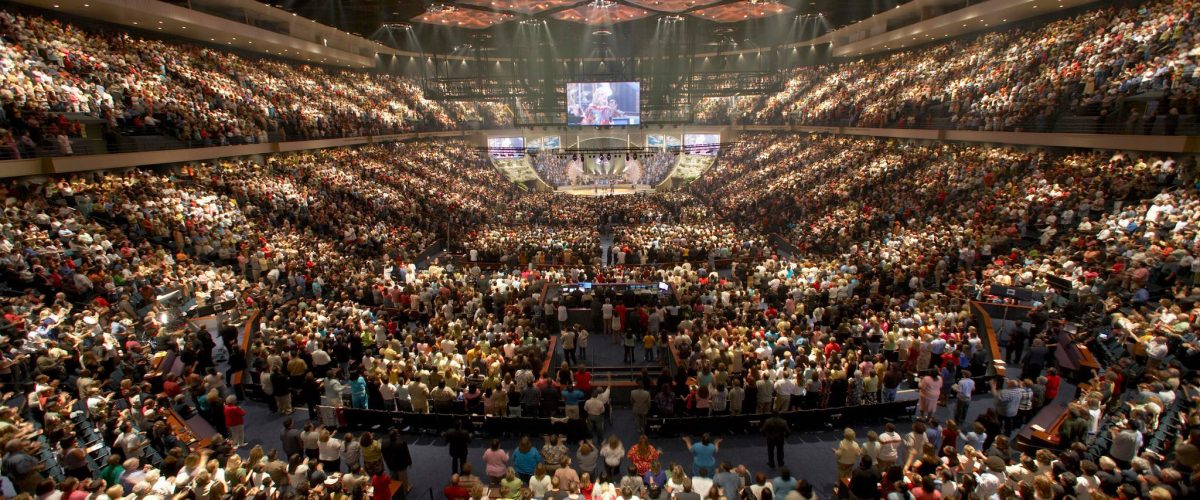Joel Osteen is an ecclesiastical phenomenon, an American, evangelical, charismatic, postmodern, megachurch, media savvy, health/wealth/motivational speaker, gospel-preacher phenomenon.
 A 59-year-old who doesn’t look it, Osteen seems made for the media — razor thin, self-effacing, pragmatic and guileless to a fault, Tom Sawyer with mousse. His sermons are folksy, positive, upbeat and encouraging, preceded each Sunday by top-drawer gospel singers from multiple musical genres. He seems a fascinating combination of old-time revivalism and new age self-help motivation.
A 59-year-old who doesn’t look it, Osteen seems made for the media — razor thin, self-effacing, pragmatic and guileless to a fault, Tom Sawyer with mousse. His sermons are folksy, positive, upbeat and encouraging, preceded each Sunday by top-drawer gospel singers from multiple musical genres. He seems a fascinating combination of old-time revivalism and new age self-help motivation.
Joel and Victoria Osteen are co-pastors of Lakewood Church in Houston, by all accounts the largest Protestant congregation in the United States, with more than 45,000 people participating in Sunday and weekday services and millions tuning in. As a nondenominational congregation, it is a case study in the nondenominationalizing of American Protestantism, a burgeoning trend in the country’s religious life.
Lakewood joins a constituency of nondenominational congregations that run from megachurches to storefront churches to startup communions nationwide.
“If ‘nondenominational’ were a denomination, it would be the largest Protestant one, claiming more than 13% of churchgoers in America.”
In a recent Christianity Today article titled “‘Nondenominational’ Is Now the Largest Segment of American Protestants,” Daniel Silliman comments, “If ‘nondenominational’ were a denomination, it would be the largest Protestant one, claiming more than 13% of churchgoers in America.” Silliman cites a 2020 U.S. Religious Census study indicating nondenominational churches outnumber Presbyterian Church (USA) congregations five times over, and six times over Episcopal congregations. Their total membership is 3.4 million more than that of the Southern Baptist Convention.
Nondenominational churches are seldom referenced in religious polling, often because the term is not considered a religious identity. Long associated with certain independent evangelical congregations, the group includes churches that began as nondenominational and others that became nondenominational after breaking ties with a parent denomination.
Political studies professor Ryan Burge distinguishes between “nones,” those who claim no formal religious affiliation, and “nons,” those who participate in nondenominational churches. He writes: “In the 1980s, just 2% of people were raised in a nondenominational church, compared to 7% who were raised Southern Baptist and 5% who were raised in the United Methodist Church. However, those percentages have shifted significantly over the last 40 years. Now, a young person is just as likely to be raised in a nondenominational church as a Southern Baptist one — but just 4% of people are being raised United Methodist.”
Burge asserts: “The two biggest stories in American religion are the nones and the nons.”
He observes that in previous decades, nondenominational congregations flourished with individuals who departed mainline Protestant denominations but are now continuing to grow through the influx of former Roman Catholics. While nondenominationalists may seek conversion of the nones, their primary constituents may be disaffected Catholics and Protestants.
“While nondenominationalists may seek conversion of the nones, their primary constituents may be disaffected Catholics and Protestants.”
Historian Sidney Mead defined a denomination as a “voluntary association of like-hearted and like-minded individuals, who are united on the basis of common beliefs for the purpose of accomplishing tangible and defined objectives.”
Denominations evolved out of 17th century English and American Puritanism as essentially an “ecumenical device,” an organizational acknowledgement that Protestants could differ on specific church polities — Congregational, Episcopal, Presbyterian — but still be part of the one true church.
Denominational distinctives made Protestant pluralism a normative, albeit embattled, reality in American churches, particularly after the Constitution and Bill of Rights ended the Puritan and Anglican religious establishments in New England and the South. They provided local churches with opportunities for organization, identity and collective support for common ministries, publications, education and mission endeavors. Denominational systems gave local churches alternatives for ministry through shared resources and programs they could not have managed on their own. Denominations also multiplied by dividing over cultural, theological and biblical issues galore.
Grace Church in Plano, Texas, defines a nondenominational church as:
A Christian church that holds no connection with the recognized denominations and mainline churches such as the Baptist, Catholic, Presbyterian, Lutheran or Methodist churches. … In denominational churches, the broader organization may set forth directives on leadership structures, membership and dogma. In nondenominational churches, each church makes decisions on various parts of church life for itself. For the most part, these churches arose out of a desire for independence and a need to return to the biblical basics of Christianity, removed from the doctrinal and sometimes political affiliations that many long-established denominational churches had accumulated over the years.
Why these ecclesiastical changes?
First, many younger clergy and laity seem less interested in or aware of denominational identity, preferring instead to claim “nondenominational” as a description for their ecclesial preferences. Many express frustrations with the multiple voices and choices spread across the denominational landscape, eschewing a tradition that brackets them into packaged beliefs and practices. Others acknowledge their dissatisfaction with sectarian warfare over doctrine, politics and practice that continues to divide denominations.
Second, nondenominational communions often seem more connected to local or regional ministries than with national ecclesial bureaucracies whose histories, dogmas and hierarchies may seem suspect, autocratic or irrelevant, assessments often shared by liberals and conservatives alike, for distinct reasons.
“Many prefer a new ecumenism evident in cross-denominational similarities and compatibilities.”
Third, many prefer a new ecumenism evident in cross-denominational similarities and compatibilities. For example, former Baptists, Methodists, Presbyterians and Pentecostals who affirm doctrines of biblical inerrancy may feel more comfortable with each other than with members of their own denominations who do not share that theory of biblical inspiration. This de facto, nondenominational unity is evident in a variety of doctrinal, liturgical, political and ethical issues.
Fourth, some of these changes are the inevitable result of a burgeoning religious consumerism or “switching” in which an increasingly fluid constituency moves from congregation to congregation, many searching for the newest program, the most enthusiastic worship or the most popular church in town. Nondenominational churches often maintain big front doors and back doors alike.
Fifth, Scott Thumma, lead researcher for the U.S. Religious Census study, suggests the growth of nondenominational churches reflects “individualism at the congregational level.” It gives evidence of an “organizational individualism that parallels personal individualism,” permitting nondenominational churches to resist the “cultural baggage” of denominational history and uniformity.
“It is an evangelistic advantage,” Thumma says. “A potential attender at a nondenominational church doesn’t have cultural expectations of what they might find inside the way they do if the brand is Episcopalian or Assemblies of God or Southern Baptist. Rather, the visitor has to experience the worship firsthand.”
How might churches, nondenominational or denominational, respond to these transitional times?
- Congregations should reaffirm identity — find a place to stand theologically and spiritually beyond generic Christianity.
- Congregations need to come to terms with their own localism, reexamining their Christian identity in a specific region and community.
- Churches should reclaim the importance of rituals, those that link them with the wider family of faith and those that identify and invigorate their own gathered community.
- Congregations might rethink the importance of dissent and conscience as a foundation for “voice” in the church and in the world. Might dissent and disagreement be possible without schism?
- Can the church move beyond the current obsessions with spiritual and ethical individualism to a renewed emphasis on covenant and the continuing relationship between the individual and the communal?
- Churches might reassert the development of signature ministries beyond the pastoral or institutional norm that provide direct responses to community and congregational needs.
The nondenominationalizing of American religion is a sign of the permanent transition that characterizes American church life. Amid ecclesiastical declines and disengagements, we wonder if it is a new reformation or another ecclesiastical fad.
Congregations nationwide would do well to reexamine who they are and what they want to be inside Christ’s gospel — while there is still time.

Bill Leonard
Bill Leonard is founding dean and the James and Marilyn Dunn professor of Baptist studies and church history emeritus at Wake Forest University School of Divinity in Winston-Salem, N.C. He is the author or editor of 25 books. A native Texan, he lives in Winston-Salem with his wife, Candyce, and their daughter, Stephanie.
Related article:
In BNG webinar, Ryan Burge details the double threat to denominational churches in America


